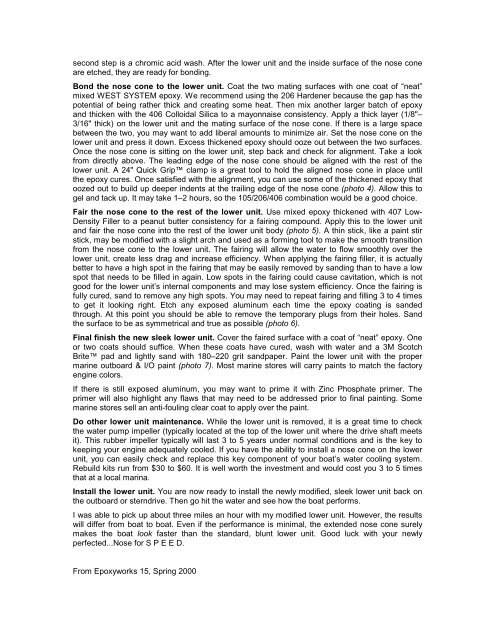You also want an ePaper? Increase the reach of your titles
YUMPU automatically turns print PDFs into web optimized ePapers that Google loves.
second step is a chromic acid wash. After the lower unit and the inside surface of the nose cone<br />
are etched, they are ready <strong>for</strong> bonding.<br />
Bond the nose cone to the lower unit. Coat the two mating surfaces with one coat of “neat”<br />
mixed <strong>WEST</strong> <strong>SYSTEM</strong> epoxy. We recommend using the 206 Hardener because the gap has the<br />
potential of being rather thick and creating some heat. Then mix another larger batch of epoxy<br />
and thicken with the 406 Colloidal Silica to a mayonnaise consistency. Apply a thick layer (1/8"–<br />
3/16" thick) on the lower unit and the mating surface of the nose cone. If there is a large space<br />
between the two, you may want to add liberal amounts to minimize air. Set the nose cone on the<br />
lower unit and press it down. Excess thickened epoxy should ooze out between the two surfaces.<br />
Once the nose cone is sitting on the lower unit, step back and check <strong>for</strong> alignment. Take a look<br />
from directly above. The leading edge of the nose cone should be aligned with the rest of the<br />
lower unit. A 24" Quick Grip clamp is a great tool to hold the aligned nose cone in place until<br />
the epoxy cures. Once satisfied with the alignment, you can use some of the thickened epoxy that<br />
oozed out to build up deeper indents at the trailing edge of the nose cone (photo 4). Allow this to<br />
gel and tack up. It may take 1–2 hours, so the 105/206/406 combination would be a good choice.<br />
Fair the nose cone to the rest of the lower unit. Use mixed epoxy thickened with 407 Low-<br />
Density Filler to a peanut butter consistency <strong>for</strong> a fairing compound. Apply this to the lower unit<br />
and fair the nose cone into the rest of the lower unit body (photo 5). A thin stick, like a paint stir<br />
stick, may be modified with a slight arch and used as a <strong>for</strong>ming tool to make the smooth transition<br />
from the nose cone to the lower unit. The fairing will allow the water to flow smoothly over the<br />
lower unit, create less drag and increase efficiency. When applying the fairing filler, it is actually<br />
better to have a high spot in the fairing that may be easily removed by sanding than to have a low<br />
spot that needs to be filled in again. Low spots in the fairing could cause cavitation, which is not<br />
good <strong>for</strong> the lower unit’s internal components and may lose system efficiency. Once the fairing is<br />
fully cured, sand to remove any high spots. You may need to repeat fairing and filling 3 to 4 times<br />
to get it looking right. Etch any exposed aluminum each time the epoxy coating is sanded<br />
through. At this point you should be able to remove the temporary plugs from their holes. Sand<br />
the surface to be as symmetrical and true as possible (photo 6).<br />
Final finish the new sleek lower unit. Cover the faired surface with a coat of “neat” epoxy. One<br />
or two coats should suffice. When these coats have cured, wash with water and a 3M Scotch<br />
Brite pad and lightly sand with 180–220 grit sandpaper. Paint the lower unit with the proper<br />
marine outboard & I/O paint (photo 7). Most marine stores will carry paints to match the factory<br />
engine colors.<br />
If there is still exposed aluminum, you may want to prime it with Zinc Phosphate primer. The<br />
primer will also highlight any flaws that may need to be addressed prior to final painting. Some<br />
marine stores sell an anti-fouling clear coat to apply over the paint.<br />
Do other lower unit maintenance. While the lower unit is removed, it is a great time to check<br />
the water pump impeller (typically located at the top of the lower unit where the drive shaft meets<br />
it). This rubber impeller typically will last 3 to 5 years under normal conditions and is the key to<br />
keeping your engine adequately cooled. If you have the ability to install a nose cone on the lower<br />
unit, you can easily check and replace this key component of your boat’s water cooling system.<br />
Rebuild kits run from $30 to $60. It is well worth the investment and would cost you 3 to 5 times<br />
that at a local marina.<br />
Install the lower unit. You are now ready to install the newly modified, sleek lower unit back on<br />
the outboard or sterndrive. Then go hit the water and see how the boat per<strong>for</strong>ms.<br />
I was able to pick up about three miles an hour with my modified lower unit. However, the results<br />
will differ from boat to boat. Even if the per<strong>for</strong>mance is minimal, the extended nose cone surely<br />
makes the boat look faster than the standard, blunt lower unit. Good luck with your newly<br />
perfected...<strong>Nose</strong> <strong>for</strong> S P E E D.<br />
From <strong>Epoxy</strong>works 15, Spring 2000
















